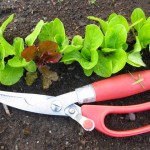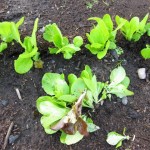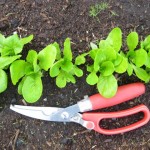Lettuce grows like crazy in May thanks to the ample daylight hours and still-cool temperatures. It’s salad heaven — the reward for planting in early spring.
Then there’s a harvest method I call progressive thinning that allows picking at every stage of growth from one planting. Here’s how it works:
- Plant lettuce seeds fairly close together, directly in the ground either in rows or broadcast. If your soil is weedy, then I recommend rows just for ease of maintenance.
- When the seedlings get large enough to form clusters of leaves, thin crowded sections by cutting out whole plants. Use scissors and cut the stem below the cotyledon. This will prevent the leaves from growing back. You could also pull out the the whole plant including the roots, but I prefer cutting the stem to avoid disturbing roots of remaining plants.
- Cut off the base of the leaves since the joint between the leaves and roots can be tough and full of grit.
- When the remaining lettuce plants grow and start to crowd each other, thin again. An occasional shot of liquid fertilizer like fish/seaweed emulsion cheers on the remaining plants.
- Continue in this manner until full-sized heads form. Pick and enjoy!
Shearing the leaves of young plants (above the cotyledon) — the cut-and-come-again method — enables repeated harvests but keeps the plants small. It’s easier at first than progressive thinning, and thus used by commercial growers, but I prefer the pleasure of watching the lettuce growing bigger by the day.Â
You can employ progressive thinning with other greens too –Chinese cabbage, kale, chard, endive, arugula and others — though some seem less tolerant of crowding than lettuce. It’s great to end up with a nice, big, juicy romaine and remember all the crunchy, tasty salads you got to eat while that select head of lettuce continued to to grow.



Leave a Reply